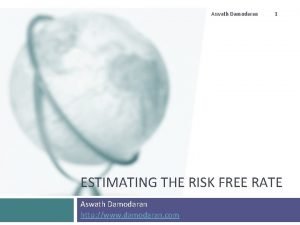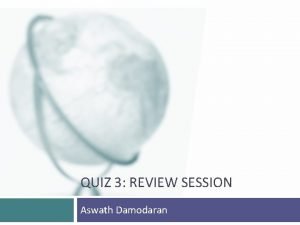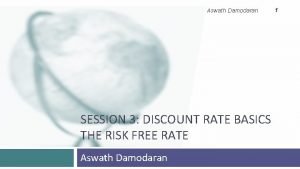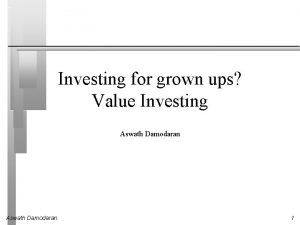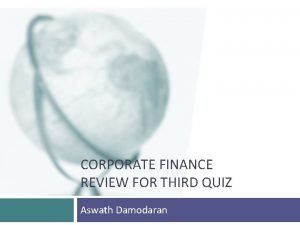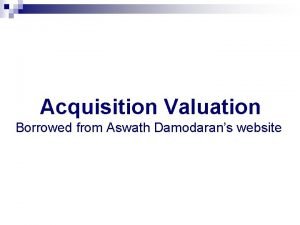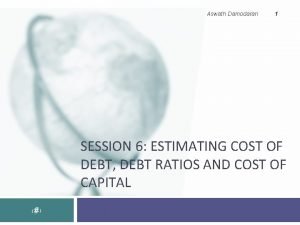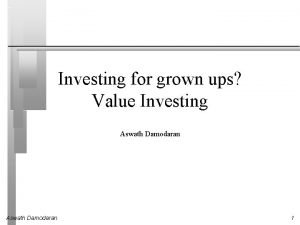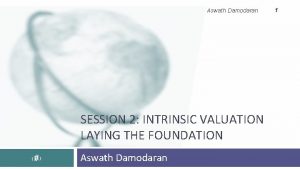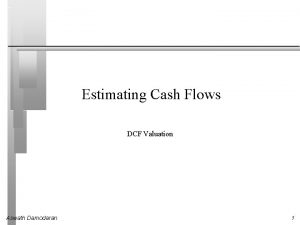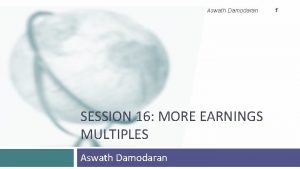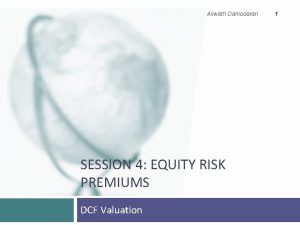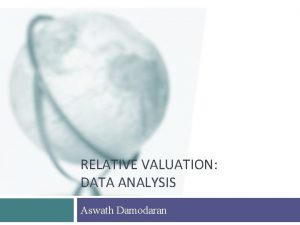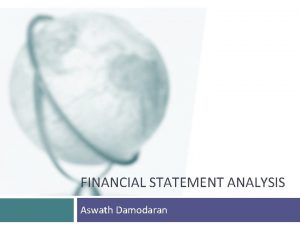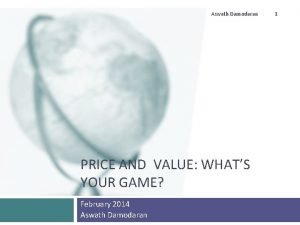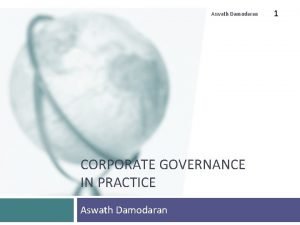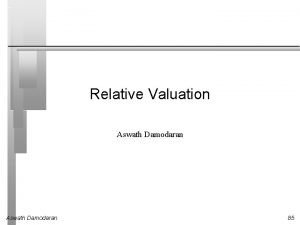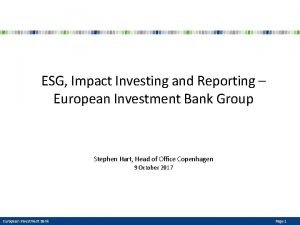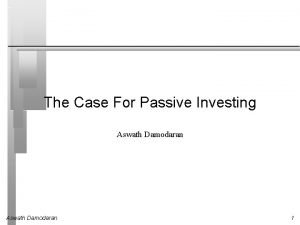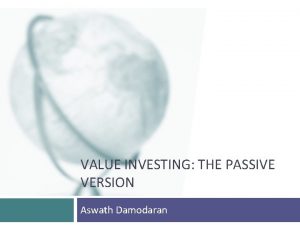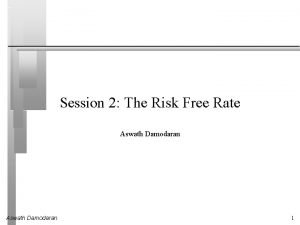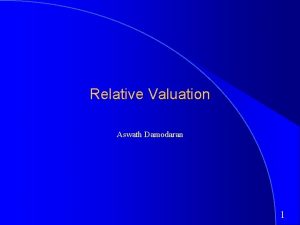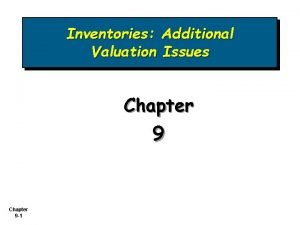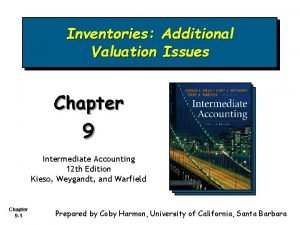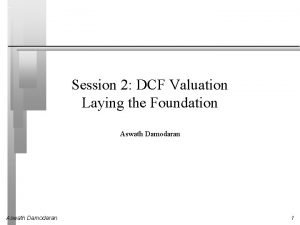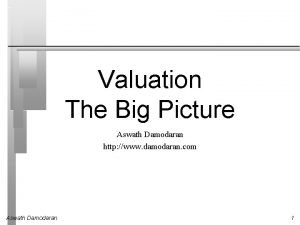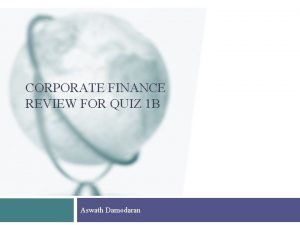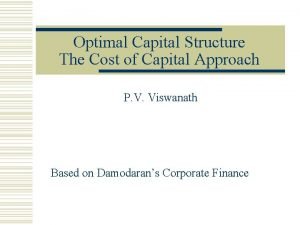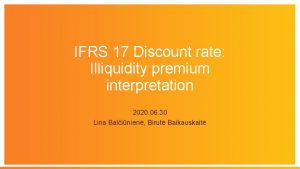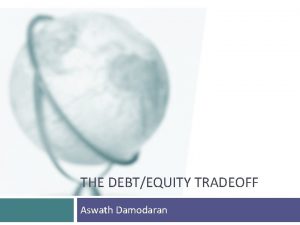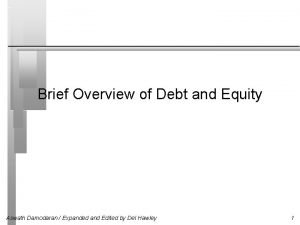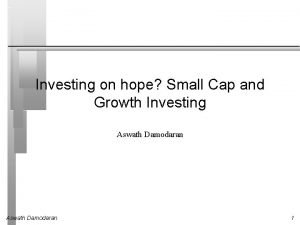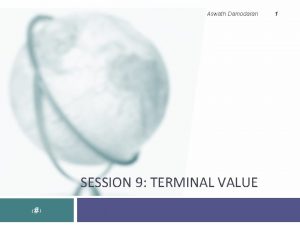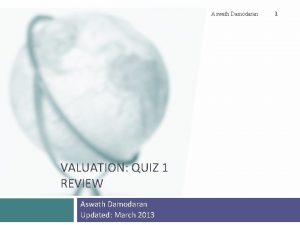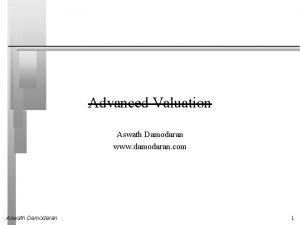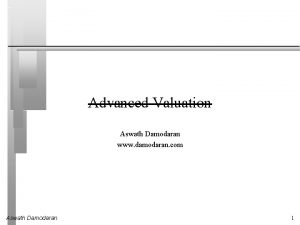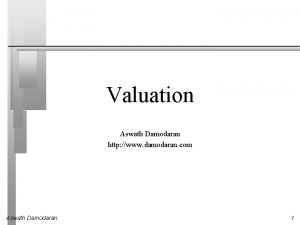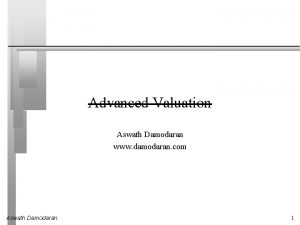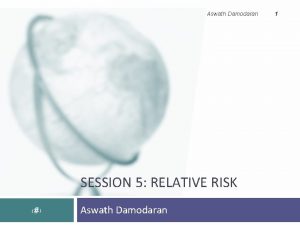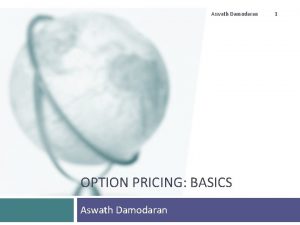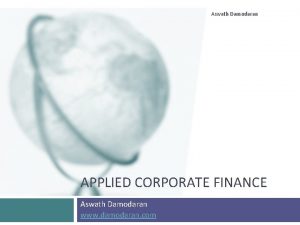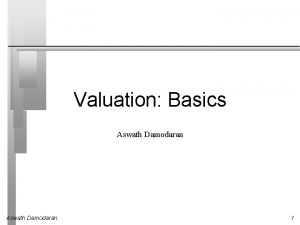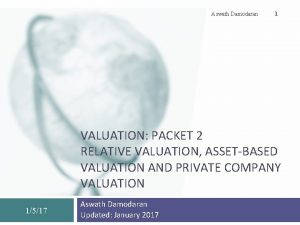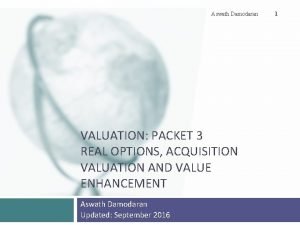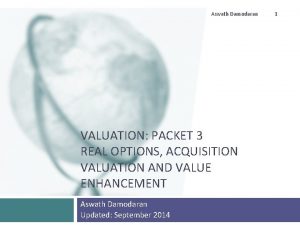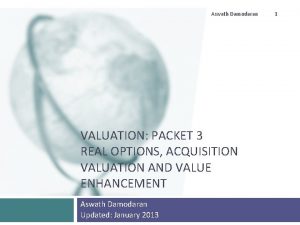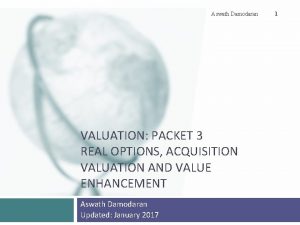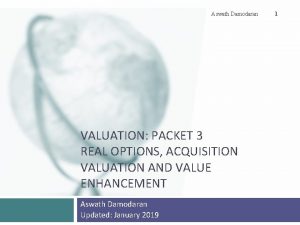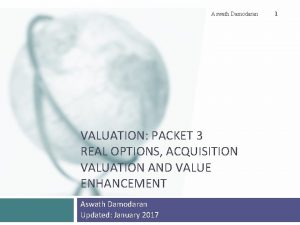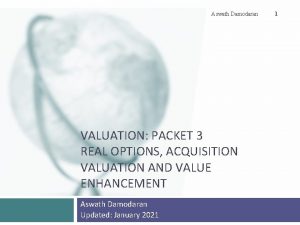Acquisition Valuation Aswath Damodaran 1 Issues in Acquisition

















































- Slides: 49

Acquisition Valuation Aswath Damodaran 1

Issues in Acquisition Valuation Acquisition valuations are complex, because the valuation often involved issues like synergy and control, which go beyond just valuing a target firm. It is important on the right sequence, including • When should you consider synergy? • Where does the method of payment enter the process. Can synergy be valued, and if so, how? What is the value of control? How can you estimate the value? Aswath Damodaran 2

Steps involved in an Acquisition Valuation Step 1: Establish a motive for the acquisition Step 2: Choose a target Step 3: Value the target with the acquisition motive built in. Step 4: Decide on the mode of payment - cash or stock, and if cash, arrange for financing - debt or equity. Step 5: Choose the accounting method for the merger/acquisition purchase or pooling. Aswath Damodaran 3

Step 1: Motives behind acquisitions (1) Simplest rationale is undervaluation, i. e. , that firms that are undervalued by financial markets, relative to true value, will be targeted for acquisition by those who recognize this anomaly. (2) A more controversial reason is diversification, with the intent of stabilizing earnings and reducing risk. (3) Synergy refers to the potential additional value from combining two firms, either from operational or financial sources. • • Operating Synergy can come from higher growth or lower costs Financial Synergy can come from tax savings, increased debt capacity or cash slack. (4) Poorly managed firms are taken over and restructured by the new owners, who lay claim to the additional value. (5) Managerial self-interest and hubris are the primary, though unstated, reasons for many takeovers. Aswath Damodaran 4

Step 2: Choose a target firm for the acquisition If motive is Target firm Undervaluation trades at a price below the estimated value Diversification is in a business which is different from the acquiring firm’s business Operating Synergy have the characteristics that create the operating synergy Cost Savings: in same business to create economies of scale. Higher growth: should have potential for higher growth. Financial Synergy Tax Savings: provides a tax benefit to acquirer Debt Capacity: is unable to borrow money or pay high rates Cash slack: has great projects/ no funds Control badly managed firm whose stock has underperformed the market. Manager’s Interestshas characteristics that best meet CEO’s ego and power needs. Aswath Damodaran 5

Step 3: Value Target Firm with motive built in If motive is Target firm Undervaluation Value target firm as stand-alone entity: No extra premium Diversification Value target firm as stand-alone entity: No extra premium Operating Synergy Value the firms independently. Value the combined firm with the operating synergy Synergy is the difference between the latter and former Target Firm Value = Independent Value + Synergy Financial Synergy Tax Benefits: Value of Target Firm + PV of Tax Benefits Debt Capacity: Value of Target Firm + Increase in Value from Debt Cash Slack: Value of Target Firm + NPV of Projects/ Target Control Value of Target Firm run optimally Manager’s Interest Value of Target Firm: No additional premium Aswath Damodaran 6

The Valuation Process Aswath Damodaran 7

Valuing NCR for AT & T: 1991 Aswath Damodaran 8

Step 4: Decide on payment mechanism: Cash versus Stock l l Generally speaking, firms which believe that their stock is under valued will not use stock to do acquisitions. Conversely, firms which believe that their stock is over or correctly valued will use stock to do acquisitions. Not surprisingly, the premium paid is larger when an acquisition is financed with stock rather than cash. There might be an accounting rationale for using stock as opposed to cash. You are allowed to use pooling instead of purchase. There might also be a tax rationale for using stock. Cash acquisitions create tax liabilities to the selling firm’s stockholders. Aswath Damodaran 9

The Exchange Ratio in a Stock for Stock Exchange l l l Correct Exchange Ratio to use in a Valuation = Value per Share of Target Firm (with control premium and target-controlled synergies) / Value per Share of Bidding Firm If the exchange ratio is set too high, there will be a transfer of wealth from the bidding firm’s stockholders to the target firm’s stockholders. If the exchange ratio is set too low, there will be transfer of wealth from the target firm to the bidding firm’s stockholders. Aswath Damodaran 10

Step 5: Choose an accounting method for the merger Purchase Method: – The acquiring firm records the assets and liabilities of the acquired firm at market value, with goodwill capturing the difference between market value and the value of the assets acquired. • This goodwill then be amortized , though the amortization is generally not tax deductible (though a portion that can be attributed to assets can be deducted). If a firm pays cash on an acquisition, it has to use the purchase method to record the transaction. Pooling of Interests: – The book values of the assets and liabilities of the merging firms are added to arrive at values for the combined firm. Since the market value of the transaction is not recognized, no goodwill is created or amortized. – This approach is allowed only if the acquiring firm exchanges its common stock for common stock of the acquired firm. – Since earnings are not affected by the amortization of goodwill, the reported earnings per share under this approach will be greater than the reported earnings per share in the purchase approach. Aswath Damodaran 11

The Value of Control The value of control should be inversely proportional to the perceived quality of that management and its capacity to maximize firm value. Value of control will be much greater for a poorly managed firm that operates at below optimum capacity than it is for a well managed firm. Value of Control = Value of firm, with restructuring - Value of firm, without restructuring Negligible or firms which are operating at or close to their optimal value Aswath Damodaran 12

Empirical Evidence on the Value of Control Aswath Damodaran 13

After the hostile takeover. . Many of the hostile takeovers were followed by an increase in leverage, which resulted in a downgrading of the debt. The leverage was quickly reduced, however, with proceeds from sale of assets. There was no significant change in the amount of capital investment in these firms, but investment was more focused on core business. Almost 60% of the takeovers were followed by significant divestitures, where half or more of the firm was divested. The overwhelming majority of the divestitures were of units which were in business areas unrelated to the company's core business, i. e. , they constituted reversal of earlier corporate diversification. There were significant management changes in 17 of the 19 hostile takeovers, with the entire corporate management team replaced in 7 of the takeovers. Aswath Damodaran 14

Stand Alone Valuation: Digital - Status Quo Digital had earning before interest and taxes of $391. 38 million in 1997, which translated into a • A pre-tax operating margin of 3% on its revenues of $13, 046 million • An after-tax return on capital of 8. 51% Based upon its beta of 1. 15, an after-tax cost of borrowing of 5% and a debt ratio of approximately 10%, the cost of capital for Digital in 1997 was • Cost of Equity = 6% + 1. 15 (5. 5%) = 12. 33% • Cost of Capital = 12. 33% (. 9) + 5% (. 1) = 11. 59% Digital had capital expenditures of $475 million, depreciation of $ 461 million and working capital was 15% of revenues. Operating income, net cap ex and revenues are expected to grow 6% a year for the next 5 years, and 5% thereafter. Aswath Damodaran 15

Digital: Status Quo Valuation Year FCFF Terminal Value PV 1 $133. 26 $119. 42 2 $141. 25 $113. 43 3 $149. 73 $107. 75 4 $158. 71 $102. 35 5 $168. 24 $2, 717. 35 $1, 667. 47 Terminal Year $156. 25 Firm Value = $2, 110. 41 The capital expenditures are assumed to be 110% of revenues in stable growth; working capital remains 15%; Debt ratio remains at 10%, but after-tax cost of debt drops to 4%. Beta declines to 1. Aswath Damodaran 16

Digital: Change in Control Digital will raise its debt ratio to 20%. The beta will increase, but the cost of capital will decrease. • • New Beta = 1. 25 (Unlevered Beta = 1. 07; Debt/Equity Ratio = 25%) Cost of Equity = 6% + 1. 25 (5. 5%) = 12. 88% New After-tax Cost of Debt = 5. 25% Cost of Capital = 12. 88% (0. 8) + 5. 25% (0. 2) = 11. 35% Digital will raise its return on capital to 11. 35%, which is its cost of capital. (Pre-tax Operating margin will go up to 4%) The reinvestment rate remains unchanged, but the increase in the return on capital will increase the expected growth rate in the next 5 years to 10%. After year 5, the beta will drop to 1, and the after-tax cost of debt will decline to 4%. Aswath Damodaran 17

Digital Valuation: Change in Control Year FCFF Terminal Value PV 1 $156. 29 $140. 36 2 $171. 91 $138. 65 3 $189. 11 $136. 97 4 $208. 02 $135. 31 5 $228. 82 $6, 584. 62 $3, 980. 29 Terminal Year $329. 23 Value of the Firm: with Control Change = $ 4, 531 million Value of the Firm: Status Quo = $ 2, 110 million Value of Control = $2, 421 million Aswath Damodaran 18

Valuing Synergy The key to the existence of synergy is that the target firm controls a specialized resource that becomes more valuable if combined with the bidding firm's resources. The specialized resource will vary depending upon the merger: • In horizontal mergers: economies of scale, which reduce costs, or from increased market power, which increases profit margins and sales. (Examples: Bank of America and Security Pacific, Chase and Chemical) • In vertical integration: Primary source of synergy here comes from controlling the chain of production much more completely. • In functional integration: When a firm with strengths in one functional area acquires another firm with strengths in a different functional area, the potential synergy gains arise from exploiting the strengths in these areas. Aswath Damodaran 19

Valuing operating synergy (a) What form is the synergy expected to take? Will it reduce costs as a percentage of sales and increase profit margins (as is the case when there are economies of scale)? Will it increase future growth (as is the case when there is increased market power)? ) (b) When can the synergy be reasonably expected to start affecting cashflows? (Will the gains from synergy show up instantaneously after the takeover? If it will take time, when can the gains be expected to start showing up? ) Aswath Damodaran 20

A procedure for valuing synergy (1) the firms involved in the merger are valued independently, by discounting expected cash flows to each firm at the weighted average cost of capital for that firm. (2) the value of the combined firm, with no synergy, is obtained by adding the values obtained for each firm in the first step. (3) The effects of synergy are built into expected growth rates and cashflows, and the combined firm is re-valued with synergy. Value of Synergy = Value of the combined firm, with synergy - Value of the combined firm, without synergy Aswath Damodaran 21

Synergy Effects in Valuation Inputs If synergy is Valuation Inputs that will be affected are Economies of Scale Operating Margin of combined firm will be greater than the revenue-weighted operating margin of individual firms. Growth Synergy More projects: Higher Reinvestment Rate (Retention) Better projects: Higher Return on Capital (ROE) Longer Growth Period Again, these inputs will be estimated for the combined firm. Aswath Damodaran 22

Valuing Synergy: Compaq and Digital In 1997, Compaq acquired Digital for $ 30 per share + 0. 945 Compaq shares for every Digital share. ($ 53 -60 per share) The acquisition was motivated by the belief that the combined firm would be able to find investment opportunities and compete better than the firms individually could. Aswath Damodaran 23

Background Data Compaq Digital: Opt Mgd Current EBIT $ 2, 987 million $ 522 million Current Revenues$25, 484 mil $13, 046 mil Capital Expenditures - Depreciation $ 184 million Expected growth rate -next 5 years 10% Expected growth rate after year 5 5% 5% Debt /(Debt + Equity) 10% 20% After-tax cost of debt 5% 5. 25% Beta for equity - next 5 years 1. 25 Beta for equity - after year 5 1. 00 Working Capital/Revenues 15% Tax rate is 36% for both companies Aswath Damodaran $ 14 1. 25 1. 0 15% 24

Valuing Compaq Year FCFF Terminal Value PV 1 $1, 518. 19 $1, 354. 47 2 $1, 670. 01 $1, 329. 24 3 $1, 837. 01 $1, 304. 49 4 $2, 020. 71 $1, 280. 19 5 $2, 222. 78 $56, 654. 81 $33, 278. 53 Terminal Year $2, 832. 74 $38, 546. 91 Value of Compaq = $ 38, 547 million After year 5, capital expenditures will be 110% of depreciation. Aswath Damodaran 25

Combined Firm Valuation The Combined firm will have some economies of scale, allowing it to increase its current after-tax operating margin slightly. The dollar savings will be approximately $ 100 million. • • Current Operating Margin = (2987+522)/(25484+13046) = 9. 11% New Operating Margin = (2987+522+100)/(25484+13046) = 9. 36% The combined firm will also have a slightly higher growth rate of 10. 50% over the next 5 years, because of operating synergies. The beta of the combined firm is computed in two steps: • • • Aswath Damodaran Digital’s Unlevered Beta = 1. 07; Compaq’s Unlevered Beta=1. 17 Digital’s Firm Value = 4. 5; Compaq’s Firm Value = 38. 6 Unlevered Beta = 1. 07 * (4. 5/43. 1) + 1. 17 (38. 6/43. 1) = 1. 16 Combined Firm’s Debt/Equity Ratio = 13. 64% New Levered Beta = 1. 16 (1+(1 -0. 36)(. 1364)) = 1. 26 Cost of Capital = 12. 93% (. 88) + 5% (. 12) = 11. 98% 26

Combined Firm Valuation Year FCFF Terminal Value PV 1 $1, 726. 65 $1, 541. 95 2 $1, 907. 95 $1, 521. 59 3 $2, 108. 28 $1, 501. 50 4 $2, 329. 65 $1, 481. 68 5 $2, 574. 26 $66, 907. 52 $39, 463. 87 Terminal Year $3, 345. 38 Value of Combined Firm = $ 45, 511 Aswath Damodaran 27

The Value of Synergy Value of Combined Firm wit Synergy Value of Compaq + Value of Digital = 38, 547 + 4532 Total Value of Synergy Aswath Damodaran = $45, 511 million = $ 43, 079 million = $ 2, 432 million 28

Digital: Valuation Blocks Value of Firm - Status Quo + Value of Control Value of Firm - Change of Control + Value of Synergy Total Value of Digital with Synergy Aswath Damodaran = $ 2, 110 million = $ 2, 521 million = $ 4, 531 million = $ 2, 432 million = $ 6, 963 million 29

Estimating Offer Prices and Exchange Ratios There are 146. 789 million Digital shares outstanding, and Digital had $1, 006 million in debt outstanding. Estimate that maximum price you would be willing to offer on this deal. Assume that Compaq wanted to do an exchange offer, where it would exchange its shares for Digital shares. Assuming that Compaq stock is valued at $27 per share, what would be the exchange ratio? Aswath Damodaran 30

Evaluating Compaq’s Offer Value of Digital with Synergy = $6, 963 mil - Value of Cash paid in deal = $ 30 * 146. 789 mil shrs = $4, 403 mil - Digitial’s Outstanding Debt (assumed by Compaq) $1, 006 mil Remaining Value $ 1, 554 mil / number of Shares outstanding 146. 789 = Remaining Value per Share $ 10. 59 Compaq’s value per share at time of Exchange Offer $ 27 Appropriate Exchange Ratio = 10. 59/27 = 0. 39 Compaq shares for every Digital share Actual Exchange Ratio = 0. 945 Compaq shares/Digital Share Aswath Damodaran 31

Citicorp + Travelers = ? Citicorp Travelers Citigroup Net Income $ 3, 591 $ 3, 104 $ BV of Equity $ 20, 722 $ 20, 736 ROE 17. 33% 14. 97% 16. 15% Dividends $ 1, 104 $ 587 $ Payout Ratio 30. 74% 18. 91% 25. 27% Retention Ratio 69. 26% 81. 09% 74. 73% Expected growth 12. 00% 12. 14% 12. 07% Growth Period 5 5 5 Beta 1. 25 1. 40 1. 33 Risk Premium 4. 00% MV of Equity (bil) 81 84 165. 00 Cost of Equity 11. 00% 11. 60% 11. 31% Beta - stable 1. 00 Growth-stable 6. 00% Payout-stable 65. 38% 59. 92% 62. 85% DDM $ 70, 743 $ 53, 464 $ 124, 009 DDM/share 155. 84 Aswath Damodaran 6, 695 $ 41, 458 1, 691 46. 38 32

The Right Exchange Ratio Based upon these numbers, what exchange ratio would you agree to as a Citicorp stockholder? The actual exchange ratio was 2. 5 shares of Travelers for every share of Citicorp. As a Citicorp stockholder, do you think that this is a reasonable exchange ratio? Aswath Damodaran 33

The Value of Synergy Aswath Damodaran 34

Financial Synergy Sources of Financial Synergy • Diversification: Acquiring another firm as a way of reducing risk cannot create wealth for two publicly traded firms, with diversified stockholders, but it could create wealth for private firms or closely held publicly traded firms. • Cash Slack: When a firm with significant excess cash acquires a firm, with great projects but insufficient capital, the combination can create value. • Tax Benefits: The tax paid by two firms combined together may be lower than the taxes paid by them as individual firms. • Debt Capacity: By combining two firms, each of which has little or no capacity to carry debt, it is possible to create a firm that may have the capacity to borrow money and create value. Aswath Damodaran 35

I. Diversification: No Value Creation? A takeover, motivated only by diversification considerations, has no effect on the combined value of the two firms involved in the takeover. The value of the combined firms will always be the sum of the values of the independent firms. In the case of private firms or closely held firms, where the owners may not be diversified personally, there might be a potential value gain from diversification. Aswath Damodaran 36

II. Cash Slack Managers may reject profitable investment opportunities if they have to raise new capital to finance them. It may therefore make sense for a company with excess cash and no investment opportunities to take over a cash-poor firm with good investment opportunities, or vice versa. The additional value of combining these two firms lies in the present value of the projects that would not have been taken if they had stayed apart, but can now be taken because of the availability of cash. Aswath Damodaran 37

Valuing Cash Slack l l l Assume that Netscape has a severe capital rationing problem, that results in approximately $500 million of investments, with a cumulative net present value of $100 million, being rejected. IBM has far more cash than promising projects, and has accumulated $4 billion in cash that it is trying to invest. It is under pressure to return the cash to the owners. If IBM takes over Netscape Inc, it can be argued that the value of the combined firm will increase by the synergy benefit of $100 million, which is the net present value of the projects possessed by the latter that can now be taken with the excess cash from the former. Aswath Damodaran 38

III. Tax Benefits (1) If one of the firms has tax deductions that it cannot use because it is losing money, while the other firm has income on which it pays significant taxes, the combining of the two firms can lead to tax benefits that can be shared by the two firms. The value of this synergy is the present value of the tax savings that accrue because of this merger. (2) The assets of the firm being taken over can be written up to reflect new market value, in some forms of mergers, leading to higher tax savings from depreciation in future years. Aswath Damodaran 39

Valuing Tax Benefits: Tax Losses Assume that you are Best Buys, the electronics retailer, and that you would like to enter the hardware component of the market. You have been approached by investment bankers for Zenith, which while still a recognized brand name, is on its last legs financially. The firm has net operating losses of $ 2 billion. If your tax rate is 36%, estimate the tax benefits from this acquisition. If Best Buys had only $500 million in taxable income, how would you compute the tax benefits? If the market value of Zenith is $800 million, would you pay this tax benefit as a premium on the market value? Aswath Damodaran 40

Valuing Tax Benefits: Asset Write Up One of the earliest leveraged buyouts was done on Congoleum Inc. , a diversified firm in ship building, flooring and automotive accessories, in 1979 by the firm's own management. • After the takeover, estimated to cost $400 million, the firm would be allowed to write up its assets to reflect their new market values, and claim depreciation on the new values. • The estimated change in depreciation and the present value effect of this depreciation, discounted at the firm's cost of capital of 14. 5% is shown below: Aswath Damodaran 41

Congoleum’s Tax Benefits Year Deprec'n before 1980 $8. 00 1981 $8. 80 1982 $9. 68 1983 $10. 65 1984 $11. 71 1985 $12. 65 1986 $13. 66 1987 $14. 75 1988 $15. 94 1989 $17. 21 1980 -89 $123. 05 Aswath Damodaran Deprec'n after $35. 51 $36. 26 $37. 07 $37. 95 $21. 23 $17. 50 $16. 00 $14. 75 $15. 94 $17. 21 $249. 42 Change in Deprec'n $27. 51 $13. 20 $27. 46 $13. 18 $27. 39 $13. 15 $27. 30 $13. 10 $9. 52 $4. 57 $4. 85 $2. 33 $2. 34 $1. 12 $0. 00 $126. 37 $60. 66 Tax Savings PV $11. 53 $10. 05 $8. 76 $7. 62 $2. 32 $1. 03 $0. 43 $0. 00 $41. 76 42

IV. Debt Capacity Diversification will lead to an increase in debt capacity and an increase in the value of the firm. Has to be weighed against the immediate transfer of wealth that occurs to existing bondholders in both firms from the stockholders. Aswath Damodaran 43

Valuing Debt Capacity When two firms in different businesses merge, the combined firm will have less variable earnings, and may be able to borrow more (have a higher debt ratio) than the individual firms. In the following example, we will combine two firms, with optimal debt ratios of 30% each, and end up with a firm with an optimal debt ratio of 40%. Aswath Damodaran 44

Effect on Costs of Capital of Added debt Firm A Firm B New Debt (%) 30% Cost of debt 6. 00% Equity(%) 70% Cost of equity 13. 60% WACC - Year 1 11. 32% WACC- Year 2 11. 32% WACC- Year 3 11. 32% WACC-Year 4 11. 32% WACC-Year 5 11. 32% WACC-after year 5 10. 55% Aswath Damodaran AB -No Debt 30% 5. 40% 70% 12. 50% 10. 37% AB - Added 40% 5. 65% 70% 12. 95% 10. 76% 10. 77% 10. 45% 5. 65% 60% 13. 65% 10. 45% 9. 76% 45

Effect on Value of Added Debt Firm A Firm B AB -No new AB - Added Debt FCFF in year 1 $120. 00 $220. 00 $340. 00 FCFF in year 2 $144. 00 $242. 00 $386. 00 FCFF in year 3 $172. 80 $266. 20 $439. 00 FCFF in year 4 $207. 36 $292. 82 $500. 18 FCFF in year 5 $248. 83 $322. 10 $570. 93 Terminal Value $5, 796. 97 $7, 813. 00 $13, 609. 97 $16, 101. 22 Present Value $4, 020. 91 $5, 760. 47 $9, 781. 38 $11, 429. 35 The value of the firm, as a consequence of the added debt, will increase from $9, 781. 38 million to $11, 429. 35 million. Aswath Damodaran 46

Empirical Evidence on Synergy If synergy is perceived to exist in a takeover, the value of the combined firm should be greater than the sum of the values of the bidding and target firms, operating independently. V(AB) > V(A) + V(B) Bradley, Desai and Kim (1988) use a sample of 236 inter-firm tender offers between 1963 and 1984 and report that the combined value of the target and bidder firms increases 7. 48% ($117 million in 1984 dollars), on average, on the announcement of the merger. Operating synergy was the primary motive in one-third of hostile takeovers. (Bhide) Aswath Damodaran 47

Operational Evidence on Synergy o A stronger test of synergy is to evaluate whether merged firms improve their performance (profitability and growth), relative to their competitors, after takeovers. o Mc. Kinsey and Co. examined 58 acquisition programs between 1972 and 1983 for evidence on two questions o Did the return on the amount invested in the acquisitions exceed the cost of capital? o Did the acquisitions help the parent companies outperform the competition? o They concluded that 28 of the 58 programs failed both tests, and 6 failed at least one test. o o KPMG in a more recent study of global acquisitions concludes that most mergers (>80%) fail - the merged companies do worse than their peer group. Large number of acquisitions that are reversed within fairly short time periods. bout 20. 2% of the acquisitions made between 1982 and 1986 were divested by 1988. In studies that have tracked acquisitions for longer time periods (ten years or more) the divestiture rate of acquisitions rises to almost 50%. Aswath Damodaran 48

Who gets the benefits of synergy? The sharing of the benefits of synergy among the two players will depend in large part on whether the bidding firm's contribution to the creation of the synergy is unique or easily replaced. If it can be easily replaced, the bulk of the synergy benefits will accrue to the target firm. It is unique, the sharing of benefits will be much more equitable. Bradley, Desai and Kim (1988) conclude that the benefits of synergy accrue primarily to the target firms when there are multiple bidders involved in the takeover. They estimate that the market-adjusted stock returns around the announcement of the takeover for the successful bidder to be 2%, in single bidder takeovers, and -1. 33%, in contested takeovers. Aswath Damodaran 49
 Aswath damodaran
Aswath damodaran Aswath damodaran risk free rate
Aswath damodaran risk free rate Aswath damodaran statistics
Aswath damodaran statistics Damodaran on valuation review
Damodaran on valuation review Damodaran discount rates
Damodaran discount rates Aswath damodaran value investing
Aswath damodaran value investing Damodaran discount rate
Damodaran discount rate Quiz
Quiz Damodaran portfolio
Damodaran portfolio Www.damodaran
Www.damodaran Damodarans
Damodarans Cost of debt damodaran
Cost of debt damodaran Damodaran
Damodaran Aswath damodaran intrinsic value
Aswath damodaran intrinsic value Damodaran dcf
Damodaran dcf Ebitda multiples for trucking companies
Ebitda multiples for trucking companies Aswath damodaran erp
Aswath damodaran erp Data damodaran
Data damodaran Types of investment philosophies
Types of investment philosophies Aswath damodaran accounting
Aswath damodaran accounting Contrarian value investing
Contrarian value investing Damodaran discount rate
Damodaran discount rate Multiples damodaran
Multiples damodaran Aswath damodaran intrinsic value
Aswath damodaran intrinsic value Aswath damodaran age
Aswath damodaran age Relative valuation damodaran
Relative valuation damodaran Aswath damodaran value investing
Aswath damodaran value investing Aswath damodaran
Aswath damodaran Aswath damodaran esg
Aswath damodaran esg Aswath damodaran net worth
Aswath damodaran net worth Damodaran
Damodaran Aswath damodaran value investing
Aswath damodaran value investing Aswath damodaran risk free rate
Aswath damodaran risk free rate Damodaran private company valuation
Damodaran private company valuation Relative valuation
Relative valuation Fixed income valuation methods
Fixed income valuation methods Chapter 9 inventories additional valuation issues
Chapter 9 inventories additional valuation issues Lower of cost or market
Lower of cost or market Krashen's monitor model
Krashen's monitor model Dcf aswath
Dcf aswath Http://www.damodaran.com
Http://www.damodaran.com Bottom up beta formula
Bottom up beta formula Disney capital structure
Disney capital structure Capital structure example problems
Capital structure example problems Ifrs 17 illiquidity premium
Ifrs 17 illiquidity premium Valuing private businesses
Valuing private businesses Damodaran tax rate
Damodaran tax rate Damodaran debt to equity
Damodaran debt to equity Damodaran
Damodaran Terminal value damodaran
Terminal value damodaran

